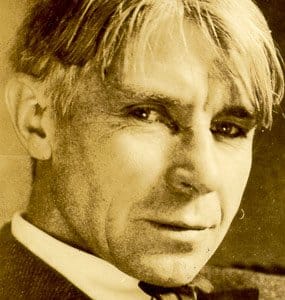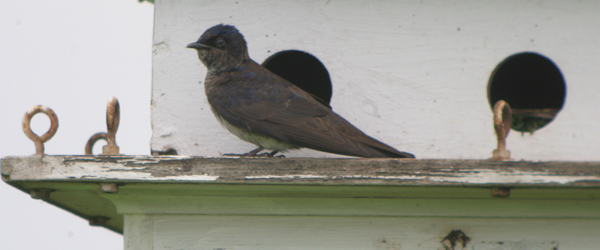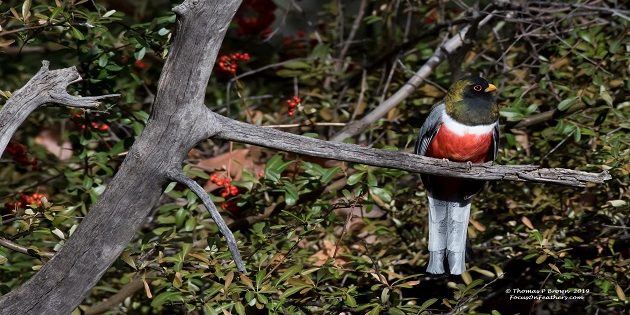“Purple Martins” first appeared in print in Carl Sandburg’s 1920 collection of poems, Smoke and Steel, published six years  after he rose to prominence following the publication of some of his poems in the famed Poetry magazine. Though one thinks automatically of Chicago when one thinks of Sandburg if one thinks of anything at all he actually wrote poems on a variety of topics. And though the collection in which this poem was published has a distinctly industrial title there are several poems that are clearly about nature including another bird poem, “Sandpipers.” It helps to remember that a mere hundred years ago, when electricity and automobiles were still fantasies for most Americans, people lived in much closer contact with nature and it wasn’t just birders who could and would see and understand the basic character of the birds they saw.
after he rose to prominence following the publication of some of his poems in the famed Poetry magazine. Though one thinks automatically of Chicago when one thinks of Sandburg if one thinks of anything at all he actually wrote poems on a variety of topics. And though the collection in which this poem was published has a distinctly industrial title there are several poems that are clearly about nature including another bird poem, “Sandpipers.” It helps to remember that a mere hundred years ago, when electricity and automobiles were still fantasies for most Americans, people lived in much closer contact with nature and it wasn’t just birders who could and would see and understand the basic character of the birds they saw.
Before I delve into details about the poem I should probably share it with you so we have a text in common:
Purple Martins
If we were such and so, the same as these,
maybe we too would be slingers and sliders,
tumbling half over in the water mirrors,
tumbling half over at the horse heads of the sun,
tumbling our purple numbers.Twirl on, you and your satin blue.
Be water birds, be air birds.
Be these purple tumblers you are.Dip and get away
From loops into slip-knots,
Write your own ciphers and figure eights.
It is your wooded island here in Lincoln park.
Everybody knows this belongs to you.Five fat geese
Eat grass on a sod bank
And never count your slinging ciphers,
your sliding figure eights.A man on a green paint iron bench,
Slouches his feet and sniffs in a book,
And looks at you and your loops and slip-knots,
And looks at you and your sheaths of satin blue,
And slouches again and sniffs in the book,
And mumbles: It is an idle and a doctrinaire exploit.Go on tumbling half over in the water mirrors.
Go on tumbling half over at the horse heads of the sun.
Be water birds, be air birds.
Be these purple tumblers you are.
What is there to analyze here? Sandburg obviously appreciates the martins’ flying skills, the “ciphers and figure eights” of the “purple tumblers” in the air overhead. The poem is placed in Chicago by the use of “Lincoln park” which is both a neighborhood and a park on Chicago’s Lake Michigan shoreline. Beyond the martins there are two other presences in the poem – the “Five fat geese” and the “man on a green paint iron bench.” The geese simply serve as a foil to the martins, emphasizing the latter’s speed, grace, and lack of connection to the ground. The man is much more interesting and his utterance requires some thought to parse.
It is clear by the way the man is presented, twice slouching and sniffing, that he is meant to be viewed unsympathetically and in opposition to the ethos of the poem. He does not appreciate the martins but the poet and hopefully the reader do. But why does the man not like the martins? He explains, saying that the “loops and slip-knots” are “an idle and a doctrinaire exploit.” What?
Apparently the man with his head buried in a book is not interested in the “idle” behavior of birds, and, by extension, those who would watch them. He views the martins’ exploits in the air as “doctrinaire” which essentially means that he feels that the martins apply their acrobatics whether or not they need them, even if such behavior is impractical. To go out on a limb in this analysis it seems that the man with his head in a book is opposed to art for art’s sake and would only appreciate didactic art. Interestingly, if this reading is correct, Sandburg sets up the man who is opposed to “doctrinaire” behavior by birds as doctrinaire and by expressing support for l’art pour l’art, which could be seen as pushing an instructional agenda in the poem,sets himself up as didactic. This curious tension could be the result of an over-analyses but if Sandburg did not mean for this conclusion to be reached then why did he have the man say the birds’ behavior was “idle and doctrinaire”?
Regardless of what, if any, deeper meaning “Purple Martins” has it is important to remember that Sandburg was well aware of the many different meanings that poetry could have. He even opened one of his books, Good Morning, America, with a list of thirty-eight different definitions of poetry. One of them cements Sandburg as a favorite poet of mine: “Poetry is a sky dark with a wild-duck migration.” Yes it is. Yes it is.
What does “Purple Martins” say to you?

If you liked this post and would like to browse the entire archive of poetry posts on 10,000 Birds please check out our Bird Poems page.
…













Great analysis, Corey. I will have to brush up on my Sandburg! And I’ll think of this poem whenever I pass the Purple Martin boxes that are, yes indeed, in the Lincoln Park that hugs the lakeshore!
@Meredith: Thanks, both for the complement and for confirming my assumption…